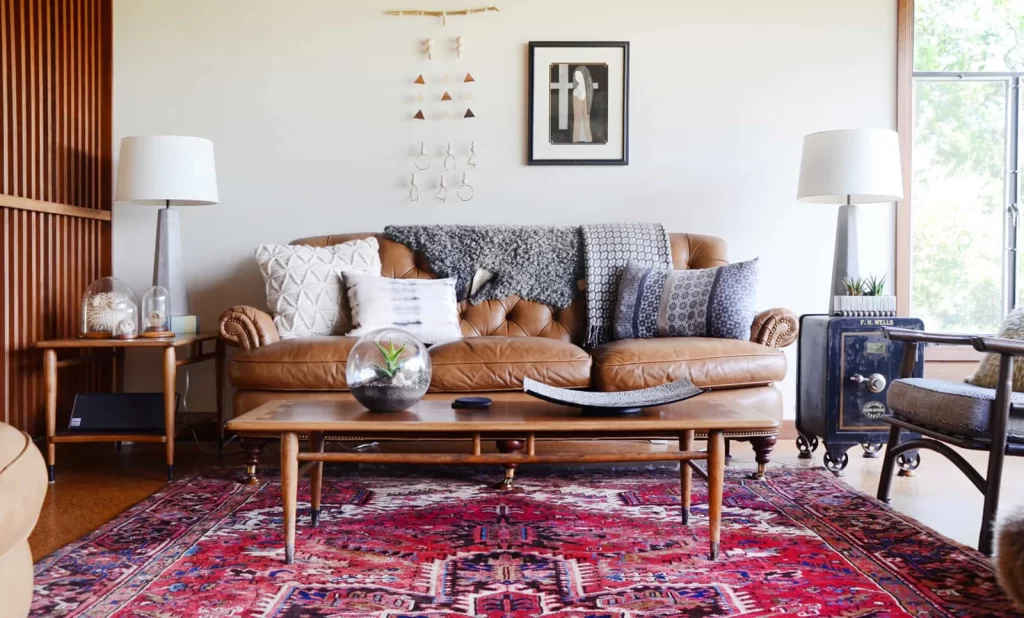When exploring Moroccan rugs, you’ll find various types, each with distinct characteristics. Berber rugs showcase intricate patterns that reflect cultural heritage, while Beni Ourain carpets offer luxurious textures and geometric designs for warmth. Azilal rugs burst with bold shapes and vibrant colors, telling unique stories through their patterns. Kilim rugs are lightweight and reversible, using flatweave techniques to create rich symbolism. Boujad rugs blend traditional and modern artistry, featuring geometric designs full of emotion. Finally, Taznakht carpets captivate with intricate designs and rich colors. To learn how these rugs can add character to your space, there’s so much more to discover.
Berber Rugs
Berber rugs, known for their unique patterns and textures, reflect the rich cultural heritage of the Berber people in Morocco. As the leading supplier of Moroccan rugs, we celebrate how these rugs tell stories of Berber history, showcasing the artisans’ skills and traditions passed down through generations. Each design holds traditional symbolism, representing various aspects of life, such as fertility, protection, and spirituality.
When you look closely at these intricate patterns, you’ll see how they convey the beliefs and values of the Berber tribes. The colors and shapes aren’t just decorative; they serve as a form of communication, connecting you to the past.
Owning a Berber rug allows you to appreciate the artistry and depth of meaning woven into every piece, bringing a piece of Moroccan culture into your home.
Beni Ourain Carpets
Among the many styles of Moroccan rugs, Beni Ourain carpets stand out for their luxurious feel and striking geometric designs. Originating from the Atlas Mountains, these rugs reflect Beni Ourain history, as they were traditionally crafted by Berber tribes using natural wool. You’ll find their thick, soft texture perfect for adding warmth to your space.
Beni Ourain symbolism is also significant; the patterns often represent the connection to nature and the spiritual beliefs of the Berber people. Each design tells a story, whether it’s a representation of fertility or protection.
When you choose a Beni Ourain carpet, you’re not just selecting a beautiful piece; you’re embracing a rich cultural heritage and a deep sense of meaning.
Azilal Rugs
When you explore Azilal rugs, you’ll notice their stunning geometric patterns that reflect the creativity of Moroccan artisans.
The vibrant colors and unique textures create a visual feast, making each piece truly one-of-a-kind.
These rugs not only serve as beautiful decor but also tell a story of the region’s rich cultural heritage.

Geometric Patterns and Designs
Azilal rugs showcase a stunning array of geometric patterns that reflect the vibrant culture and creativity of Moroccan artisans. These intricate designs carry cultural significance and often incorporate modern interpretations that resonate with contemporary aesthetics.
Here are some key features of Azilal rugs:
- Bold Shapes: Expect triangles, diamonds, and zigzags that create dynamic visual interest.
- Symbolic Meanings: Many patterns represent fertility, protection, and community.
- Unique Combinations: Each rug tells a story through its distinctive layout and design.
- Versatile Styles: They easily complement both traditional and modern home decor.
Colorful Wool and Textures
The vibrant colors and rich textures of Azilal rugs invite you to explore the artistry woven into each piece, showcasing the skill and creativity of Moroccan weavers.
Traditionally, these rugs were crafted for practical uses, such as floor coverings and bedding in rural homes. You’ll notice their bold hues and intricate patterns, which often reflect the region’s natural landscapes and cultural stories.
Today, modern adaptations make them popular in contemporary interiors, blending seamlessly with various design styles.
Whether you choose a brightly colored Azilal rug for your living room or a muted version for a cozy nook, these rugs bring warmth and character to your space, celebrating both heritage and innovation in every stitch.
Kilim Rugs
Kilim rugs are fascinating for their unique weaving techniques and vibrant color patterns.
You’ll appreciate how each design carries its own symbolism, adding depth to your space.
Plus, knowing how to care for these rugs will help you maintain their beauty for years to come.
Weaving Techniques Explained
In Morocco, artisans employ various weaving techniques to create vibrant kilim rugs that showcase intricate patterns and cultural significance. These techniques have deep roots in weaving history and rely on traditional tools passed down through generations.
When you explore kilim rugs, you’ll notice:
- Flatweave Technique: Produces lightweight, reversible rugs.
- Tapestry Weaving: Allows for detailed imagery and designs.
- Warping Methods: Creates different textures and thicknesses.
- Finishing Techniques: Enhances durability and appearance.
Each method reflects the artisan’s skill and cultural heritage, ensuring that every kilim tells its own story.
Color Patterns and Symbolism
Artisans infuse their kilim rugs with vibrant color patterns that carry deep symbolism, reflecting both personal stories and cultural heritage. Each hue and design speaks to the tradition and emotions of the weaver.
For instance, red often signifies strength and passion, while blue represents tranquility and protection. You’ll find that the pattern significance varies from region to region, with geometric shapes symbolizing harmony and balance.
Stripes can denote the passage of time or a journey, while floral motifs may express a connection to nature.
Care and Maintenance Tips
To keep your Moroccan kilim rugs looking vibrant and fresh, regular care and maintenance are crucial. Here are some tips to help you:
- Vacuum regularly: Use a vacuum without a beater bar to prevent damage while removing dust and dirt.
- Spot clean stains: Use mild soap and water for spot cleaning; avoid harsh chemicals that can fade colors.
- Rotate your rug: To guarantee even wear, rotate your kilim every few months, especially if it’s in a high-traffic area.
- Store properly: If you need to store your rug, roll it up instead of folding it, and keep it in a cool, dry place to prevent mildew.
